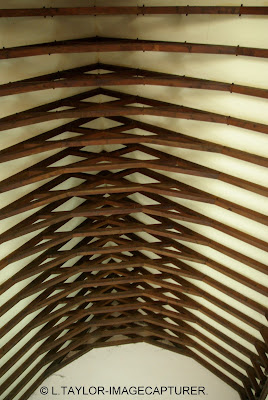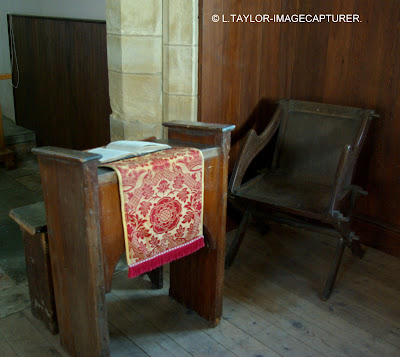THE CHURCH.
The church is dedicated to St Lawrence the deacon ( died AD 258 ), a roman martyr said to have been roasted to death on a gridiron. He is thus the patron saint of cooks. The present building was apparently begun in the later Norman period ( 12th century ) but dates substantially from the early 14th century. In late Elizabethan or Jacobean times, however, the chancel was reconstructed and enlarged to house the huge St Paul monuments. In 1820 the church was taken down in part and rebuilt by Parochial rate, at a cost of £200, while in 1856 the chancel was re-roofed and given it`s present windows. It was perhaps during one of these rebuildings that a splendid late mediaeval wrought iron railing, now displayed in the mediaeval galleries of the Victoria and Albert museum, was removed from the church. Most of these stages in it`s history have left their mark on the fabric of the church.
~~~~<<<<>>>>~~~~
THE ST PAUL FAMILY.
The St Paul family, also called St Pol and Sampoole, originated at Byram near Knottingley in west Yorkshire. They acquired the manor of Snarford in about 1400, when St Paul married Elizabeth Snarford, heiress of the previous owners. Their real rise to power and influence, however began with the Tudor Reformation, when they accumulated lands confiscated from Lincolnshire Monasteries by Henry VIII.. George St Paul ( c. 1494 - 1559 ) in particular, steered an adroit and profitable course through several changes of government. Legal adviser to the Duke of Suffolk ( Henry VIII`s principal agent in Lincolnshire ) and to the city of Lincoln, he also contrived to serve successively as an MP under the Protestant Edward VI and the Catholic Queen Mary. His son, sir Thomas, occupies the largest of the Snarford tombs.
VIEWS INSIDE THE CHURCH.
The bell tower.
Roof beams.
~~~~<<<<>>>>~~~~
OCTAGONAL FONT.
beneath the tower stands the splendid 15th century octagonal font, one of the finest in Lincolnshire. Several of its facets display the instruments of the passion - objects connected with Christ`s crucifixion. These include the cross and two scourges; pincers used for removing nails; the vinegar sponge on its stick; the IHS monogram of Christ, and the haloed head of Christ himself. Round the base of the bowl are human and demonic heads. Many such fonts were defaced as idolatrous images during the Tudor reformation, but this one is in good condition, a rather surprising fact, given the puritan views of the St Paul family.
~~~~<<<<>>>>~~~~
WALL TABLET TO FRANCES WRAY AND HER SECOND HUSBAND ROBERT RICH,
EARL OF WARWICK.
The most unusual and perhaps the best of the Snarford monuments is the wall tablet commemorating Francis Wray and her second husband Robert Rich, earl of Warwick ( D.1619 ). Probably designed by the famous sculptor Epiphanius Evesham, it depicts the heads and shoulders of the couple in low relief, framed as if in a Jacobean miniature painting. Above is their coat of arms, flanked by the white wyvern crest of the Rich family and the golden ostrich of the Wrays. Beneath is a highly complimentary epitaph to Warwick, in English verse.
~~~~<<<<>>>>~~~~
THE GREAT SIX-POSTER MONUMENT OF SIR THOMAS ST PAUL(d.1582) AND FAMILY.
MP for Grimsby and twice sheriff of Lincolnshire. Thomas was called earnest in religion, i.e. a zealous protestant, and was knighted by queen Elizabeth at Richmond in 1580. He married Faith Grantham, herself the descendant of several important Lincolnshire families, and was closely associated with the most powerful men in the county - including Thomas Tailor ( builder of Doddington Hall and Lady Faiths step father ) and sir Christopher Wray of Glentworth ( queen Elizabeths chief justice and father in law of sir Thomas`s son ). By the time he died in 1582, he had added wide estates near Grimsby and in the Isle of Axholme to the ancestral St Paul lands around Snarford. This monument is ablaze with heraldry of his family connections. The Latin inscription round the tomb reads :- here lies Thomas St .Poll, knight, who died on the 29th of August A.D. 1582, in the twenty forth year of the reign of Queen Elizabeth, and rests in Christ. Reader, you see what I am, you know what I have been, consider what you yourself must be. They lie as if on an elaborate six poster Elizabethan bed, and round the canopy above kneel their eight children, only four of whom survived infancy. The largest of the girls apparently represents Faith, who married sir Edward Tyrwhit but herself died in childbirth, and above her, on a pedestal of his own, kneels the son and heir, later sir George St Paul, Baronet.
~~~~<<<<>>>>~~~~
SIR GEORGE ST PAUL.
sir George ( D.1613 ) was the last, richest and most influential of the St Pauls. His towering alabaster monument against the chancel north wall differs considerably in character from that of sir Thomas, substituting elaborate Jacobean symbolism for a brash display of ancestry. Sir George, in Jacobean armour and cloak - bag breeches, lies stiffly propped on his elbow, in an attitude, irreverently nicknamed "The toothache posture". His wife Francis, in the same posture, wears the dark gown, wide ruff and frizzed hairstyle made fashionable by James I`s queen Anne of Denmark. Both are set against a backdrop embossed with coffins, gravediggers tools, funeral torches and other emblems of death. More symbolism surrounds the tiny effigy of their only child Mattathia, in its separate alcove below, she is flanked by the rose of eternity and the lily of purity, and by two mourning cherubs with the extinguished torches of mortality.
MATTATHIA ST PAUL.
her burial place is beneath an alcove in the south chancel wall. The baby girl was born and christened at Louth, but was apparently never strong. For while returning to Bath, presumably for her own health, she died at Coventry in September 1597 at the age of one year and ten months. She was bought back to Snarford for burial.
One of the two mourning cherubs.
~~~~<<<<>>>>~~~~
A FEW MORE PHOTOGRAPHS OF ITEMS IN THE CHURCH.
~~~~<<<<>>>>~~~~





























Would it be safe to say this is amazing? The beauty of the church itself and all the different items inside are truly something else. The history of the place alone is beyond reproach. There is just so much to take in here. I'm going to come back and read it again. This is great. Might be the best you have done, my friend!
ReplyDelete